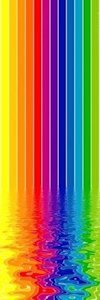
|
ISCC-NBS Dictionary of Color Names
The ISCC-NBS System of Color Designation is a system for naming colors based on
a set of 12 basic color terms and a small set of adjective modifiers. It was
first established in the 1930s by a joint effort of the Inter-Society Color
Council, made up of delegates from various American trade organizations, and
the National Bureau of Standards, a US government agency. As suggested in 1932
by the first chairman of the ISCC, the system's goal is to be "a means of
designating colors in the United States Pharmacopoeia, in the National
Formulary, and in general literature ... such designation to be sufficiently
standardized as to be acceptable and usable by science, sufficiently broad to
be appreciated and used by science, art, and industry, and sufficiently
commonplace to be understood, at least in a general way, by the whole public."
The system aims to provide a basis on which color definitions in fields from
fashion and printing to botany and geology can be systematized and regularized,
so that each industry need not invent its own incompatible color system.
In 1939, the system's approach was published in the Journal of Research of the
National Bureau of Standards, and the ISCC formally approved the system, which
consisted of a set of blocks within the color space defined by the Munsell
color system as embodied by the Munsell Book of Color. Over the following
decades the ISCC-NBS system's boundaries were tweaked and its relation to
various other color standards were defined, including for instance those for
plastics, building materials, botany, paint, and soil. After the definition of
the Munsell system was slightly altered by its 1943 renotation, the ISCC-NBS
system was redefined in the 1950s in relation to the new Munsell coordinates.
In 1955, the NBS published The Color Names Dictionary, which cross-referenced
terms from several other color systems and dictionaries, relating them to the
ISCC-NBS system and thereby to each other. In 1965, the NBS published Centroid
Color Charts made up of color samples demonstrating the central color in each
category, as a physical representation of the system usable by the public, and
also published The Universal Color Language, a more general system for color
designation with various degrees of precision from completely generic (13 broad
categories) to extremely precise (numeric values from spectrophotometric
measurement). In 1976, The Color Names Dictionary and The Universal Color
Language were combined and updated with the publication of Color: Universal
Language and Dictionary of Names, the definitive source on the ISCC-NBS system.
On to Page 2
Return
|
